Charles E W Bean, Diaries, AWM38 3DRL 606/270 PART 3/1 - 1918 - 1939 - Part 2

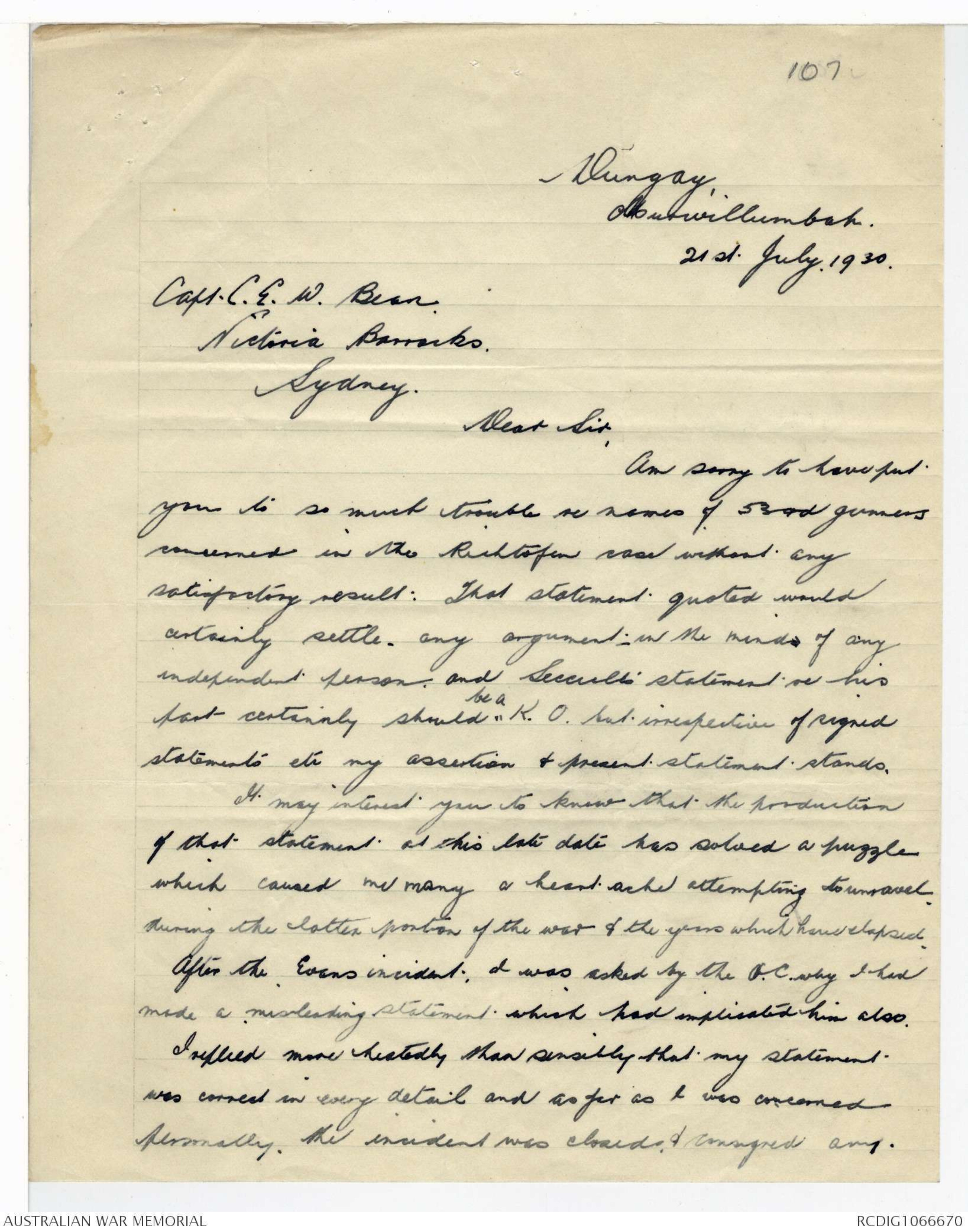
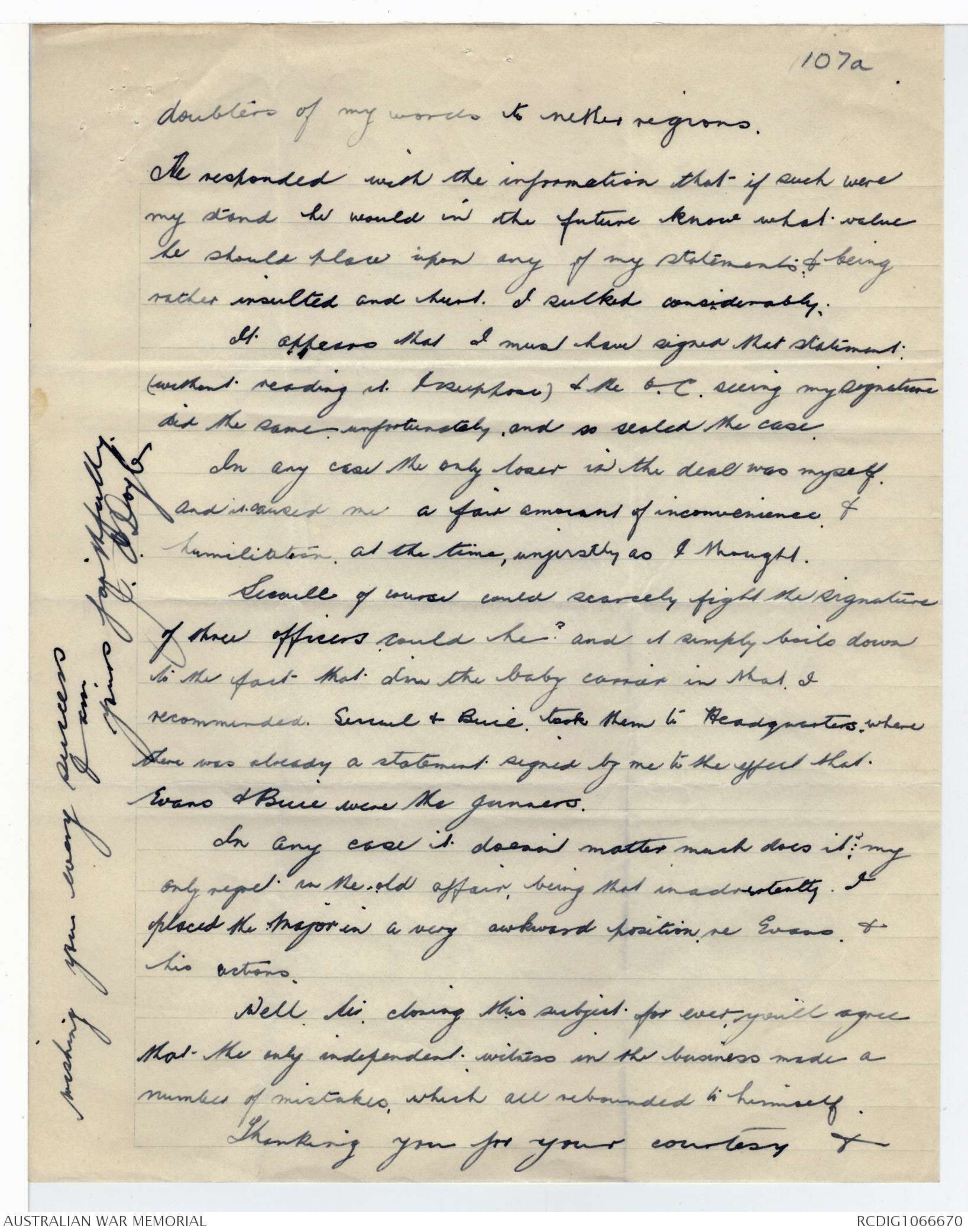
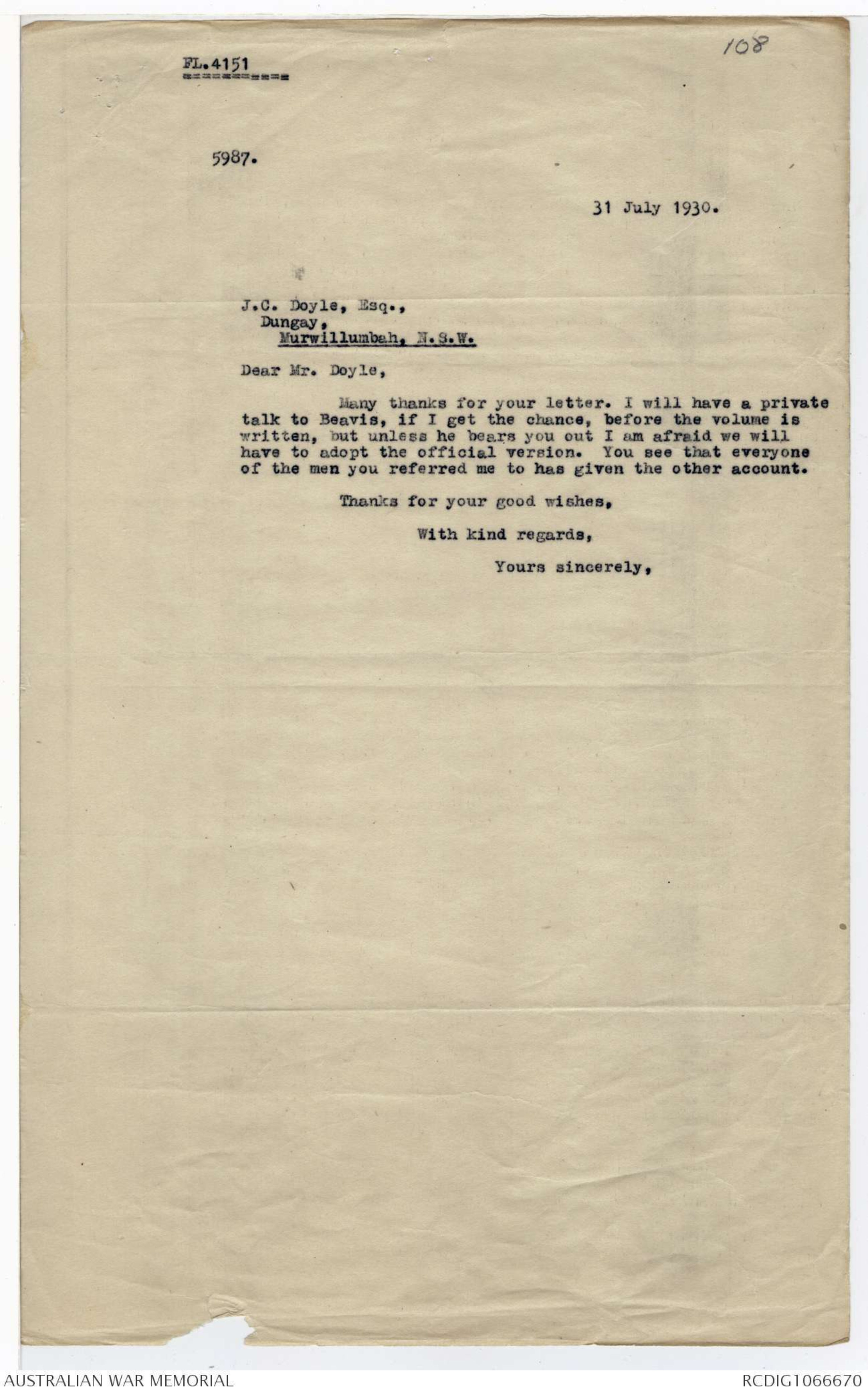
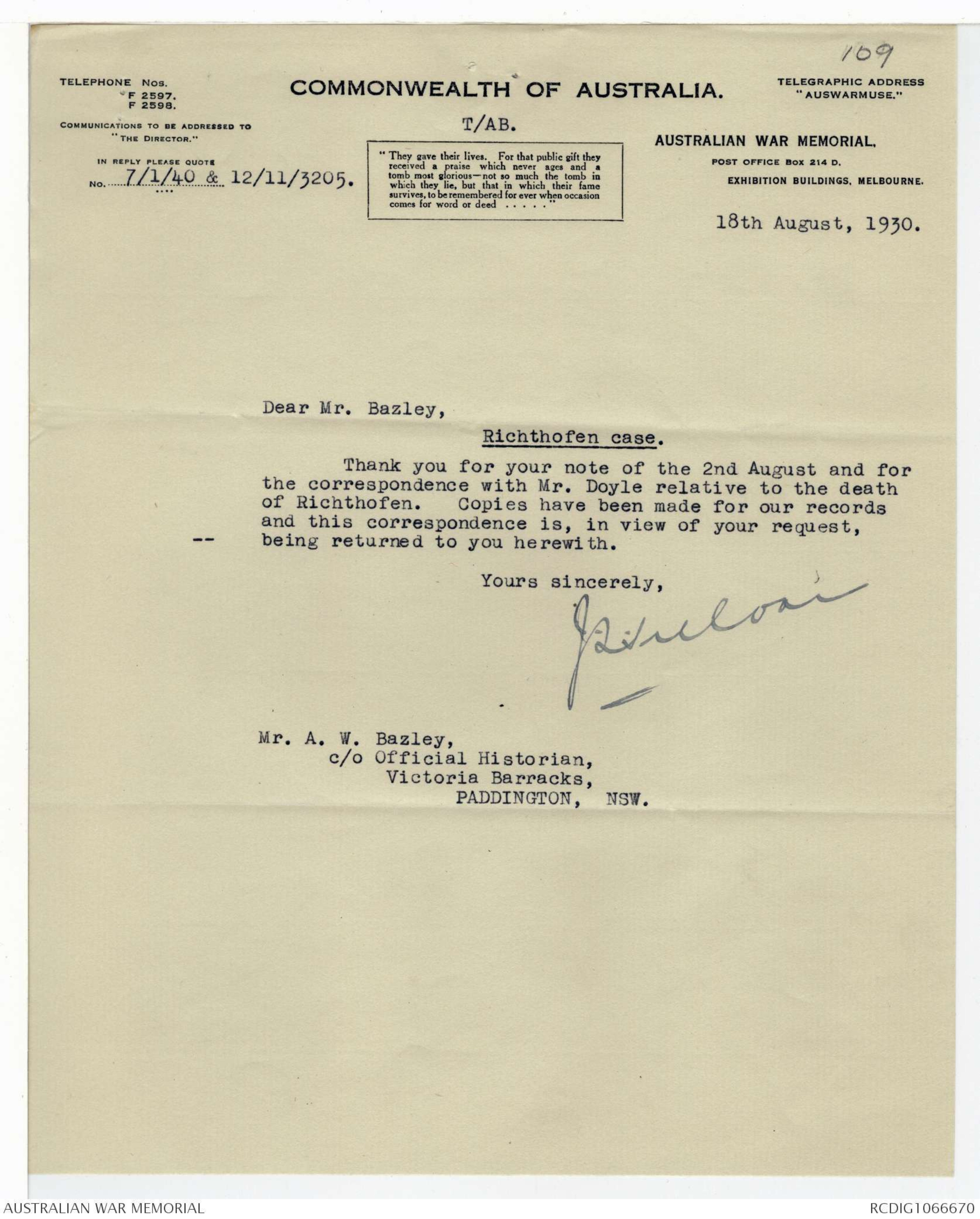
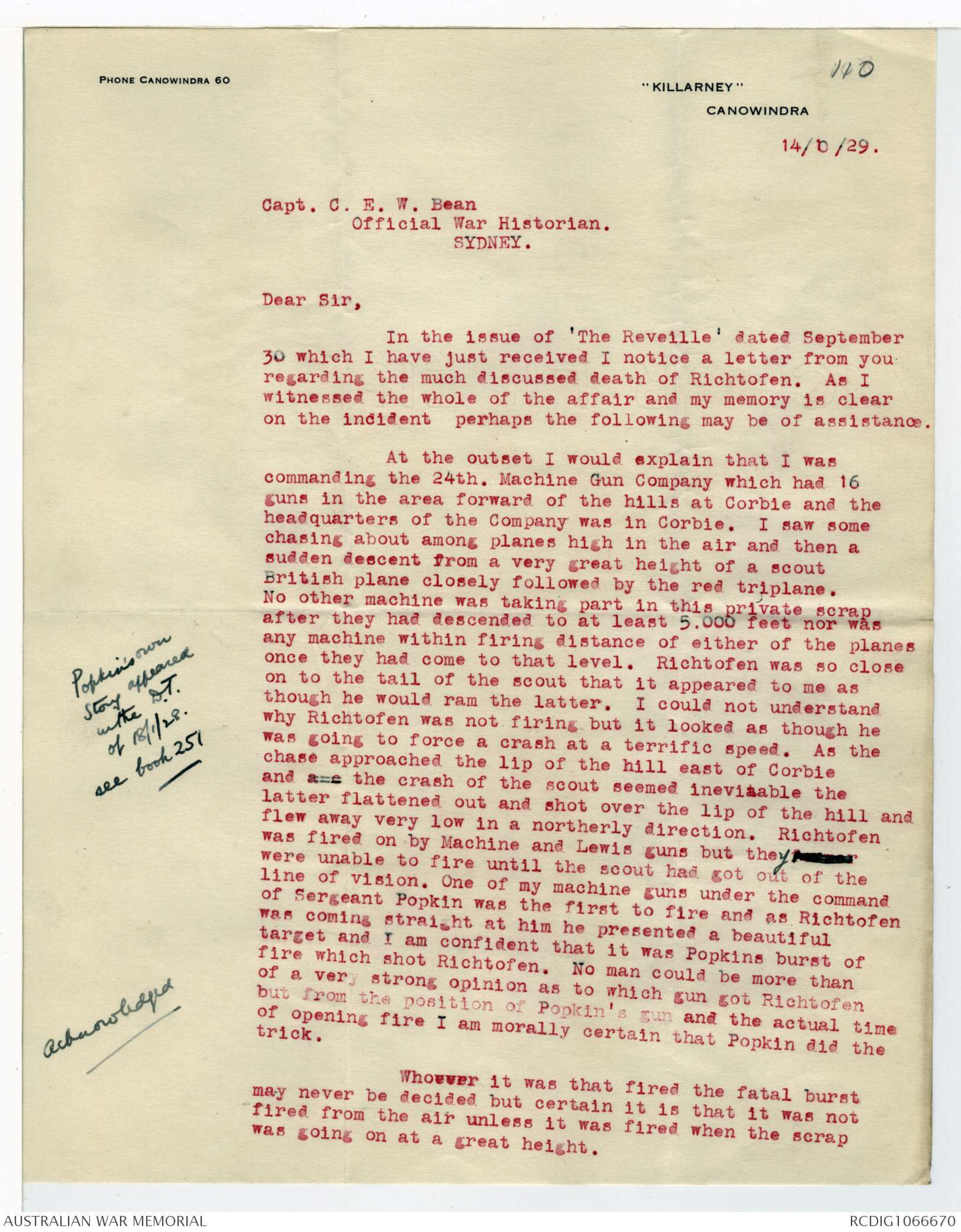
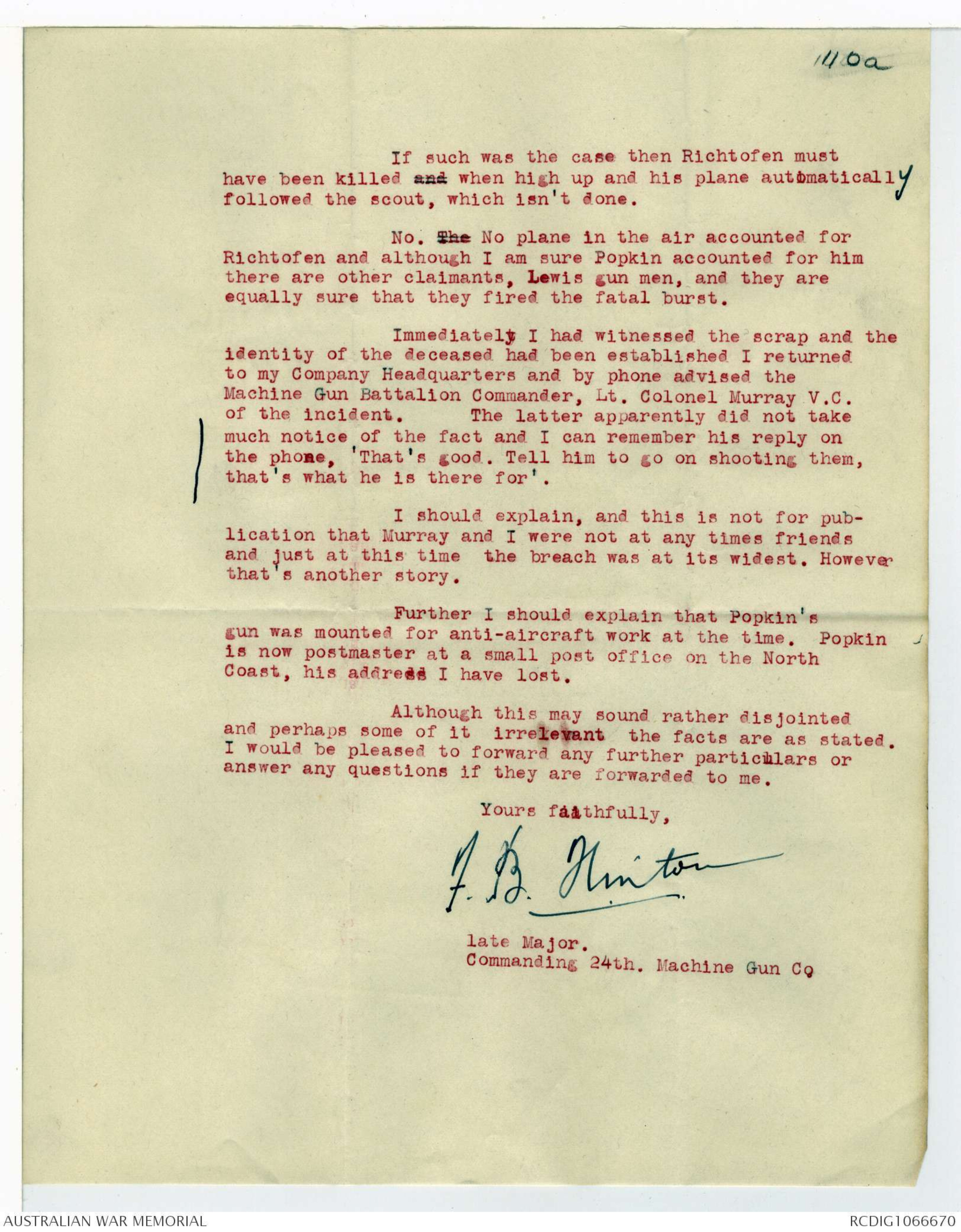

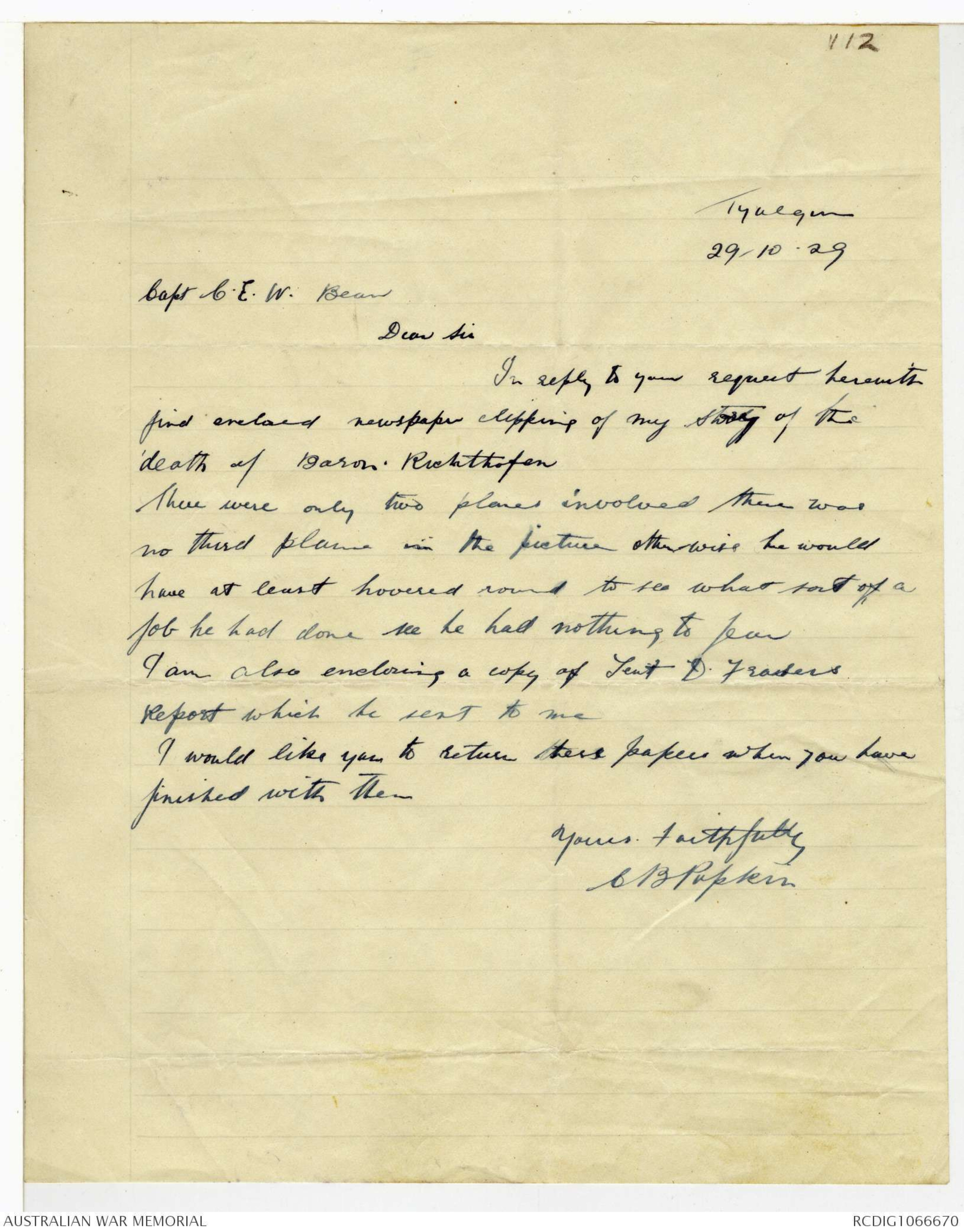
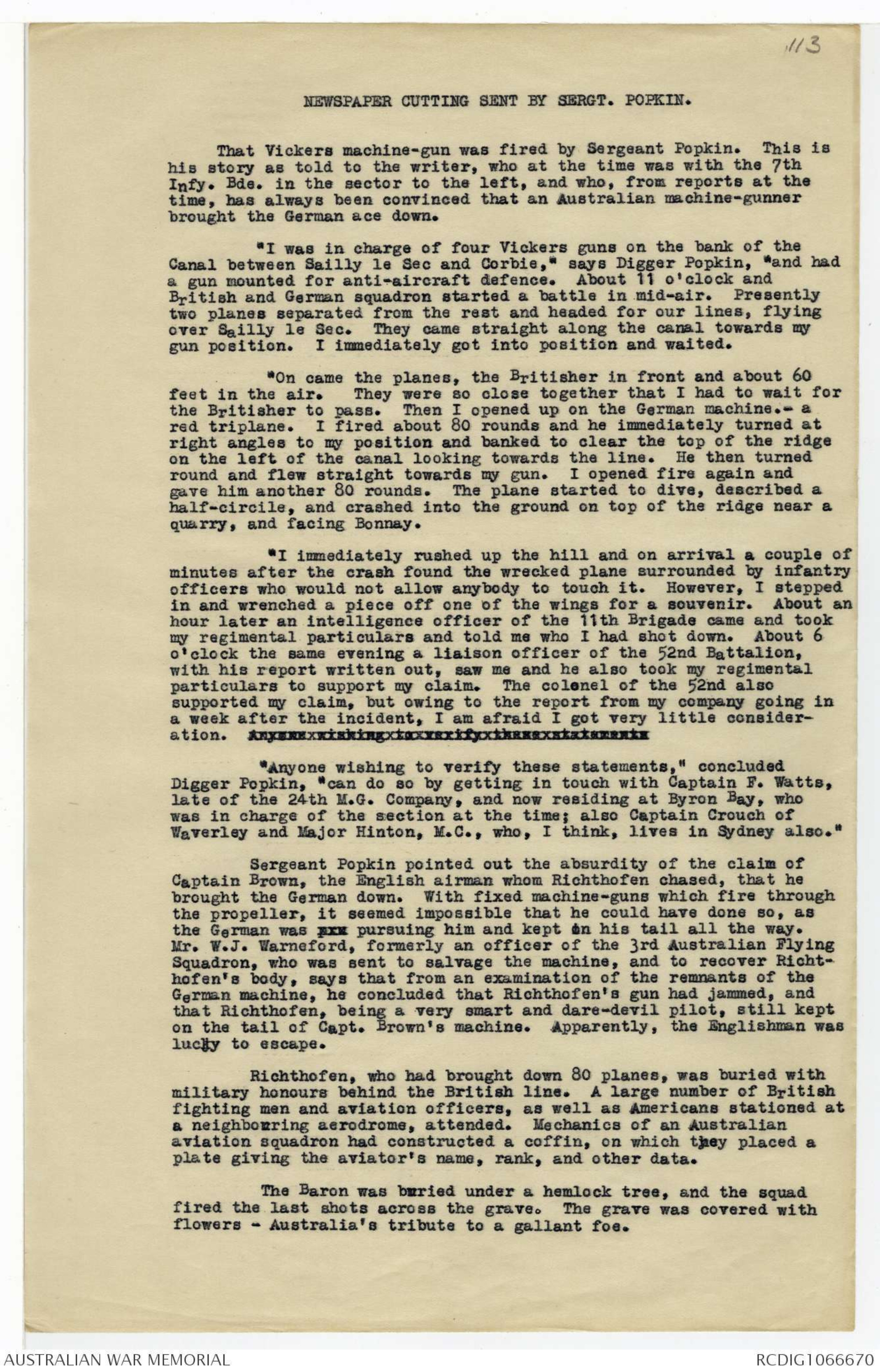
AWM No. 7/1/40
106
5901.
4 June 1930.
Dear Mr. Treloar,
RICHTHOFEN’S DEATH.
With reference to your letter of April 9 last, you
will be pleased to learn that we have now tracked down the
original statements made by Lieutenants Doyle and Ellis and
Major Beavis.
Having learned of the address of ex-Bombardier
Seccull, who had charge of the 53rd Battery's Lewis guns on the
day Richthofen was brought down, we communicated with him,
since Lieutenant Doyle persisted in saying that Seccull and
Buie were the gunners concerned and not Evans and Buie. With
his reply Seccull enclosed the original statements signed by
the three abovementioned officers, a copy of which you sent to
me on March 6. There is no doubt that Doyle's memory has
slipped him up, for the signature is his all right.
We have, at his request, returned the original
statements to Seccull, who lives at 84 Beach Road, Sandringham,
Victoria. 1 shall accordingly include a letter for him with
next month's batch of War Memorial letters.
Yours sincerely,
CMBeagley
Mr. J.L. Treloar
Australian War Memorial,
Box 214D, G.P.O.,
Melbourne.
107
Dungay,
Murwillumbah
21st. July. 1930.
Capt. C. E. W. Bean
Victoria Barracks
Sydney
Dear Sir,
Am sorry to have put
you to so much trouble re names of 53rd gunners
concerned in the Richthofen case without any
satisfactory result. That statement quoted would
certainly settle. any argument in the minds of any
independent person and Seccults' statement re his
part certainly should^be a K.O. but irrespective of signed
statements etc my assertion & present statement stands.
It may interest you to know that the production
of that statement at this late date has solved a puzzle
which caused me many a heart ache attempting to unravel
during the latter portion of the war of the years which have lapsed.
After the Evans incident, I was asked by the O.C. why I had
made a misleading statement which had implicated him also.
I replied more heatedly than sensibly that my statement
was correct in every detail and as far as I was concerned
personally. the incident was closed & consigned any.
107a
doubters of my words to nether regions
He responded with the information that if such were
my stand he would in the future know what value
he should place upon any of my statements & being
rather insulted and hurt. I sulked considerably
It appears that I must have signed that statement
(without reading it I suppose) and the O.C. seeing my signature
did the same unfortunately, and so settled the case.
In any case the only loser is the deal was myself.
and it caused me a fair amount of inconvenience &
humiliation. at the time, unjustly as I thought.
Seccull of course could scarcely fight the signature
of three officers could he? and it simply boils down
it the fact that I'm the baby carrier in that. I
recommend Seccull & Buie took them to Headquarters. where
There was already a statement signed by me to the effect that.
Evans & Buie were the gunners.
In any case it doesn’t matter much does it; my
only regret in the old affair, being that inadvertently. I
placed the Major in a very awkward position re Evans &
his actions.
Well in closing this subject for ever you'll agree
that the only independent witness in the business made a
number of mistakes, which all rebounded to himself.
Thinking you for your courtesy &
[*wishing you every success
& [[?]]
Yours Faithfully.
JC Doyle
108
FL.4151
5987.
31 July 1930.
J.C. Doyle, Esq.,
Dungay
Murwillumbah. N.S.W.
Dear Mr. Doyle,
Many thanks for your letter. I will have a private
talk to Beavis, if 1 get the chance, before the volume is
written, but unless he bears you out I am afraid we will
have to adopt the official version. You see that everyone
of the men you referred me to has given the other account.
Thanks for your good wishes,
With Kind regards,
Yours sincerely,
109
Telegraphic Address.
“AUSWARMUSE”
AUSTRALIAN WAR MEMORIAL
Post Office Box 214D
EXHIBITION BUILDING, MELBOURNE
18th August, 1930.
Telephone No’s
F2597
F 2598
COMMONWEALTH OF AUSTRALIA
T/AB.
Communication to be addressed
“The Director””
In reply please quote
No 7/1/40 & 12/11/3205.
They gave their lives. For that public gift
they received a praise that never ages and a
tomb most glorious - not so much the tomb in
which they lie, but that in which their fame
survives to be remembered for ever when occasion
came comes for word or deed…..
Dear Mr. Bazley,
Richthofen case.
Thank you for your note of the 2nd August and for
the correspondence with Mr. Doyle relative to the death
of Richthofen. Copies have been made for our records
and this correspondence is, in view of your request,
being returned to you herewith.
Yours sincerely,
J L Treloar
Mr. A. W. Bazley,
c/o Official Historian,
Victoria Barracks,
PADDINGTON, N.S.W.
140
Phone Canowindra 60
“Killarney”
Canowindra
14/10/29
Capt. C. E. W. Bean
Official War Historian.
SYDNEY.
Dear Sir,
In the issue of The Reveille dated September
30 which I have just received I notice a letter from you
regarding the much discussed death of Richtofen. As I
witnessed the whole of the affair and my memory is clear
on the incident perhaps the following may be of assistance,
At the outset I would explain that I was
commanding the 24th. Machine Gun Company which had 16
guns in the area forward of the hills at Corbie and the
headquarters of the Company was in Corbie. I saw some
chasing about among planes high in the air and then a
sudden descent from a very great height of a scout
British plane closely followed by the red triplane.
No other machine was taking part in this private scrap
after they had descended to at least 5,000 feet nor was
any machine within firing distance of either of the planes
once they had come to that level. Richtofen was so close
on to the tail of the scout that it appeared to me as
though he would rain the latter. I could not understand
why Richtofen was not firing but it looked as though he
was going to force a crash at a terrific speed. As the
chase approached the lip of the hill east of Corbie
and a s the crash of the scout seemed inevitable the
latter flattened out and shot over the lip of the hill and
flew away very low in a northerly direction. Richtofen
was fired on by Machine and Lewis guns but they xxxxx
were unable to fire until the scout had got out of the
line of vision. One of my machine guns under the command
of Sergeant Popkin was the first to fire and as Richtofen
was coming straight at him he presented a beautiful
target and I am confident that it was Popkins burst of
fire which shot Richtofen. No man could be more than
of a very strong opinion as to which gun got Richtofen
but from the position of Popkin’s gun and the actual time
of opening fire I am morally certain that Popkin did the
trick.
Whoever it was that fired the fatal burst
may never be decided but certain it is that it was not
fired from the air unless it was fired when the scrap
was going on at a great height.
[*Popkins own
story appeared
with the D.T.
of 18/1/28.
see book 251*]
[*acknowledged*]
110a
1f such was the case then Richtofen must
have been killed and when high up and his plane automatically
followed the scout, which isn't done.
No. The No plane in the air accounted for
Richtofen and although I am sure Popkin accounted for him
there are other claimants, Lewis gun men, and they are
equally sure that they fired the fatal burst.
Immediately I had witnessed the scrap and the
identity of the deceased had been established I returned
to my Company Headquarters and by phone advised the
Machine Gun Battalion Commander, Lt. Colonel Murray V.C.
of the incident. The latter apparently did not take
much notice of the fact and I can remember his reply on
the phone, 'That's good. Tell him to go on shooting them,
thats what he is there for'.
I should explain, and this is not for publication
that Murray and I were not at any times friends
and just at this time the breach was at its widest. However
thats another story.
Further I should explain that Popkin's
gun was mounted for anti-aircraft work at the time. Popkin
is now postmaster at a small post office on the North
Coast, his address I have lost.
Although this may sound rather disjointed
and perhaps some of it irrelevant the facts are as stated.
I would be pleased to forward any further particulars or
answer any questions if they are forwarded to me.
Yours faithfully,
F.B. Hinton
late Major
Commanding 24th. Machine Gun Co
FL.4151 111
5044.
23 October 1929.
C.B. Popkin, Esq.,
Tyalgum N.S.W.
Dear Sir.
In connection with the death of Baron Richthofen, I am
anxious to secure precise information as to whether there were
two or three aeroplanes involved. According to the account given
by Captain A.R. Brown, R.F.C., who claims to have shot him down,
Richthofen was closely pursuing a British scout, and Brown himself
in a third machine was almost, if not quite, equally close on top
of Richthofen. Brown does not claim to have shot Richthofen high
in the air, but close to the ground, and his account therefore
stands or falls by the question whether, when Richthofen was
racing over the hills near Corbie on the 21st of April, 1918,
there were three aeroplanes involved, or two.
As I understand from Major Hinton that you were on spot
with your machine-gun and put a burst into the red machine,
should be grateful 1f you would let me have your account of the
affair.
Yours faithfully,
CEWBean
Captain
Official Historian.
112
Tyalgum
29.10.29
Capt C.E.W. Bean
Dear Sir
In reply to you request herewith
find enclosed newspaper clipping of my story of the
death of Baron. Richthofen.
There were only two planes involved there was
no third plane in the picture otherwise he would
have at least hovered round to see what sort of a
job he had done see he had nothing to fear.
I am also enclosing a copy of Lent D. Frasers
Report which he sent to me
I would like you to return the papers when you have
finished with them
Yours Faithfully
CB Popkin
113
NEWSPAPER CUTTING SENT BY SERGT. POPKIN
That Vickers machine-gun was fired by Sergeant Popkin. This is
his story as told to the writer, who at the time was with the 7th
Infy. Bde. in the sector to the left, and who, from reports at the
time, has always been convinced that an Australian machine-gunner
brought the German ace down.
"I was in charge of four Vickers guns on the bank of the
Canal between Sailly le Sec and Corbie," says Digger Popkin, "and had
a gun mounted for anti- aircraft defence. About 11 o'clock and
British and German squadron started a battle in mid-air. Presently
two planes separated from the rest and headed for our lines, flying
over Sailly le Sec. They came straight along the canal towards my
gun position. I immediately got into position and waited.
"On came the planes, the Britisher in front and about 60
feet in the air. They were so close together that I had to wait for
the Britisher to pass. Then I opened up on the German machine.- a
red triplane. I fired about 80 rounds and he immediately turned at
right angles to my position and banked to clear the top of the ridge
on the left of the canal looking towards the line. He then turned
round and flew straight towards my gun. I opened fire again and
gave him another 80 rounds. The plane started to dive, described a
half-circle, and crashed into the ground on top of the ridge near a
quarry, and facing Bonnay.
“I immediately rushed up the hill and on arrival a couple of
minutes after the crash found the wrecked plane surrounded by infantry
officers who would not allow anybody to touch it. However, I stepped
in and wrenched a piece off one of the wings for a souvenir. About an
hour later an intelligence officer of the 11th Brigade came and took
my regimental particulars and told me who I had shot down. About 6
o'clock the same evening a liaison officer of the 52nd Battalion,
with his report written out, saw me and he also took my regimental
particulars to support my claim. The colonel of the 52nd also
supported my claim, but owing to the report from my company going in
a week after the incident, I am afraid I got very little consideration.xxxxxxxxxxxxxxxxxxxxxxxxxxxxxxxk
“Anyone wishing to verify these statements”, concluded
Digger Popkin, “(can do so by getting in touch with Captain F. Watts,
late of the 24th M.G. Company, and now residing at Byron Bay, who
was in charge of the section at the time; also Captain Crouch of
Waverley and Major Hinton, M.C. who, I think, lives in Sydney also.”
Sergeant Popkin pointed out the absurdity of the claim of
Captain Brown, the English airman whom Richthofen chased, that he
brought the German down. With fixed machine-guns which fire through
the propeller, it seemed impossible that he could have done so, as
the German was xxx pursuing him and kept an his tail all the way.
Mr. W.J. Warneford, formerly an officer of the 3rd Australian Flying
Squadron, who was sent to salvage the machine, and to recover Richthofen's
body, says that from an examination of the remnants of the
German machine, he concluded that Richthofen's gun had jammed, and
that Richthofen, being a very smart and dareedevil pilot, still kept
on the tail of Capt. Brown's machine. Apparently, the Englishman was
lucky to escape.
Richthofen, who had brought down 80 planes, was buried with
military honours behind the British line. A large number of British
fighting men and aviation officers, as well as Americans stationed at
a neighbouring aerodrome, attended. Mechanics of an Australian
aviation squadron had constructed a coffin, on which they placed a
plate giving the aviator's name, rank, and other data.
The Baron was buried under a hemlock tree, and the squad
fired the last shots across the grave. The grave was covered with
flowers - Australia’s tribute to a gallant foe.
 Sandy Mudie
Sandy MudieThis transcription item is now locked to you for editing. To release the lock either Save your changes or Cancel.
This lock will be automatically released after 60 minutes of inactivity.